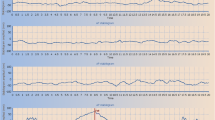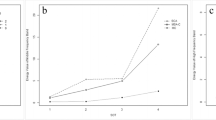Abstract
The aim of this study is to evaluate the prevalence and electrophysiological features of 3-Hz postural tremor in multiple system atrophy-cerebellar type and spinocerebellar ataxia. A static posturography examination was administered to 37 persons with spinocerebellar ataxia, 58 others with the cerebellar type of multiple system atrophy, and 53 healthy controls. During the sensory organization tests of 5 multiple system atrophy patients, surface electromyograms were recorded from bilateral tibialis anterior and medial gastrocnemius muscles. The patients with multiple system atrophy had, on average, significantly higher scores on the International Cooperative Ataxia Rating Scale and significantly greater prevalence of cross sign. Almost 80% of them fell during the posturography testing compared with two-thirds of the spinocerebellar ataxia patients. Twenty-seven percent of the spinocerebellar ataxia patients and 82.8% of those with multiple system atrophy displayed postural tremor with a frequency of approximately 3 Hz. The tremor’s frequency tended to be lower in the spinocerebellar ataxia patients. The surface electromyography revealed highly coherent tremor activity at about 3 Hz in the patients’ bilateral tibialis anterior and alternating firing in the bilateral antagonist muscles. Combining cross sign with a subject’s static score of the International Cooperative Ataxia Rating Scale and occurrence of the tremor produced an indicator able to differentiate the two conditions with a sensitivity of 87.9% and a specificity of 89.2%. The area under the receiver operating characteristics curve for the indicator was 0.942. Three-hertz postural tremor is relatively characteristic of cerebellar type of multiple system atrophy and appears at an early stage of the disease. Identification of the tremor by posturography will facilitate its diagnosis.




Similar content being viewed by others

Change history
03 March 2022
A Correction to this paper has been published: https://doi.org/10.1007/s12311-022-01372-w
References
Krismer F, Wenning GK. Multiple system atrophy: insights into a rare and debilitating movement disorder. Nat Rev Neurol. 2017;13(4):232–43.
Yabe I, Soma H, Takei A, Fujiki N, Yanagihara T, Sasaki H. MSA-C is the predominant clinical phenotype of MSA in Japan: analysis of 142 patients with probable MSA. J Neurol Sci. 2006;249(2):115–21.
Kim HJ, Jeon BS, Shin J, Lee WW, Park H, Jung YJ, et al. Should genetic testing for SCAs be included in the diagnostic workup for MSA? Neurology. 2014;83(19):1733–8.
Li M, Ma Q, Zhao X, Wang C, Wu H, Li J, et al. Dilemma of multiple system atrophy and spinocerebellar ataxias. J Neurol. 2018;265(12):2764–72.
Terao Y, Fukuda H, Tokushige S, et al. Distinguishing spinocerebellar ataxia with pure cerebellar manifestation from multiple system atrophy (MSA-C) through saccade profiles. Clin Neurophysiol. 2016;128(1):31.
Silfverskiold BP. Romberg’s test in the cerebellar syndrome occurring in chronic alcoholism. Acta Neurol Scand. 1969;45(3):292–302.
Mauritz KH, Dichgans J, Hufschmidt A. Quantitative analysis of stance in late cortical cerebellar atrophy of the anterior lobe and other forms of cerebellar ataxia. Brain. 1979;102(3):461–82.
Diener HC, Dichgans J, Bacher M, Gompf B. Quantification of postural sway in normals and patients with cerebellar diseases. Electroencephalogr Clin Neurophysiol. 1984;57(2):134–42.
Sullivan EV, Rose J, Pfefferbaum A. Effect of vision, touch and stance on cerebellar vermian-related sway and tremor: a quantitative physiological and MRI study. Cereb Cortex. 2006;16(8):1077–86.
Li X, Wang Y, Wang Z, Xu Y, Zheng W. 3-Hz postural tremor in multiple system atrophy cerebellar type (MSA-C): a static posturography study. Neurol Sci. 2018;39(1):71–7.
Nilsson BY, Silfverskiold BP. Electromyographic recordings of slow leg tremor in chronic alcoholics. Acta Neurol Scand. 1973;49(2):227–32.
Asahina M, Nakajima M, Kojima S, Hirayama K. Postural sway in patients with hereditary ataxia. Rinsho Shinkeigaku. 1994;34(11):1105–10.
Sullivan EV, Rose J, Pfefferbaum A. Physiological and focal cerebellar substrates of abnormal postural sway and tremor in alcoholic women. Biol Psychiatry. 2010;67(1):44–51.
Gan SR, Wang J, Figueroa KP. Postural tremor and ataxia progression in spinocerebellar ataxias. Tremor Other Hyperkinet Mov (N Y). 2017;7:492.
Bonnet C, Apartis E, Anheim M. Tremor-spectrum in spinocerebellar ataxia type 3. J Neurol. 2012;11:2460–70.
Sarva H, Severt WL, Jacoby N. Secondary orthostatic tremor in the setting of cerebellar degeneration. J Clin Neurosci. 2016;27:173–5.
Gilman S, Wenning GK, Low PA. Second consensus statement on the diagnosis of multiple system atrophy. Neurology. 2008;71(9):670–6.
Karlberg M, Fransson PA, Magnusson M. Posturography can be used to screen for primary orthostatic tremor, a rare cause of dizziness. Otol Neurotol. 2005;26(6):1200–3.
Elble R, Deuschl G. Milestones in tremor research. Mov Disord. 2011;26(6):1096–105.
Feil K, Bottcher N, Guri F. Long-term course of orthostatic tremor in serial posturographic measurement. Parkinsonism Relat Disord. 2015;21(8):905–10.
Yarrow K, Brown P, Gresty MA. Force platform recordings in the diagnosis of primary orthostatic tremor. Gait Posture. 2001;13(1):27–34.
van Gerpen JA. A retrospective study of the clinical and electrophysiological characteristics of 32 patients with orthostatic myoclonus. Parkinsonism Relat Disord. 2014;20(8):889–93.
Spiegel J, Krick C, Fuss G. Orthostatic tremor during modification of standing. Clin Neurophysiol. 2006;21(2):173–8.
Mauritz KH, Schmitt C, Dichgans J. Delayed and enhanced long latency reflexes as the possible cause of postural tremor in late cerebellar atrophy. Brain. 1981;104(Pt 1):97–116.
Rigby HB, Rigby MH, Caviness JN. Orthostatic tremor: a spectrum of fast and slow frequencies or distinct entities? Tremor Other Hyperkinet Mov (N Y). 2015;5:324.
Kollensperger M, Geser F, Seppi K. Red flags for multiple system atrophy. Mov Disord. 2008;23(8):1093–9.
Osaki Y, Wenning GK, Daniel SE. Do published criteria improve clinical diagnostic accuracy in multiple system atrophy? Neurology. 2002;59(10):1486–91.
Wermuth L, Cui X, Greene N. Medical record review to differentiate between idiopathic Parkinson’s disease and Parkinsonism: a Danish record linkage study with 10 years of follow-up. Parkinsons Dis. 2015;2015:781479.
Van de Warrenburg BP, Bakker M, Kremer BP. Trunk sway in patients with spinocerebellar ataxia. Mov Disord. 2005;20(8):1006–13.
Setta F, Manto MU. Orthostatic tremor associated with a pontine lesion or cerebellar disease. Neurology. 1998;51:923.
Benito-León J, Rodríguez J, Ortí-Pareja M. Symptomatic orthostatic tremor in pontine lesions. Neurology. 1997;49(5):1439–41.
Wu YR, Ashby P, Lang AE. Orthostatic tremor arises from an oscillator in the posterior fossa. Mov Disord. 2001;16:272–9.
Wills AJ, Thompson PD, Findley LJ. A positron emission tomography study of primary orthostatic tremor. Neurology. 1996;46(3):747–52.
Funding
This study was founded by National Natural Foundation of China (81901396), Medical Science Research Grant of Guangdong Province (B2018088, A2019439), The Sixth Affiliated Hospital of Sun Yat-Sen University Clincal Research - 1010 Program (1010PY(2020)-44).
Author information
Authors and Affiliations
Corresponding authors
Ethics declarations
Conflict of Interests
The authors declare that they have no conflict of interest.
Ethical Approval
This study was approved by the local institution’s ethics committees.
Additional information
Publisher’s Note
Springer Nature remains neutral with regard to jurisdictional claims in published maps and institutional affiliations.
Supplementary Information
Supplementary File 1
Illustration of cerebellar vermis atrophy in this study. From left to right: mild cerebellar vermis atrophy, moderate cerebellar vermis atrophy, severe cerebellar vermis atrophy (PNG 492 kb).
Rights and permissions
About this article
Cite this article
Li, X., Lv, X., Liu, C. et al. 3-Hz Postural Tremor in MSA-C and SCA: Revisiting an Old but Underestimated Cerebellar Sign by Posturography. Cerebellum 20, 246–253 (2021). https://doi.org/10.1007/s12311-020-01209-4
Accepted:
Published:
Issue Date:
DOI: https://doi.org/10.1007/s12311-020-01209-4



